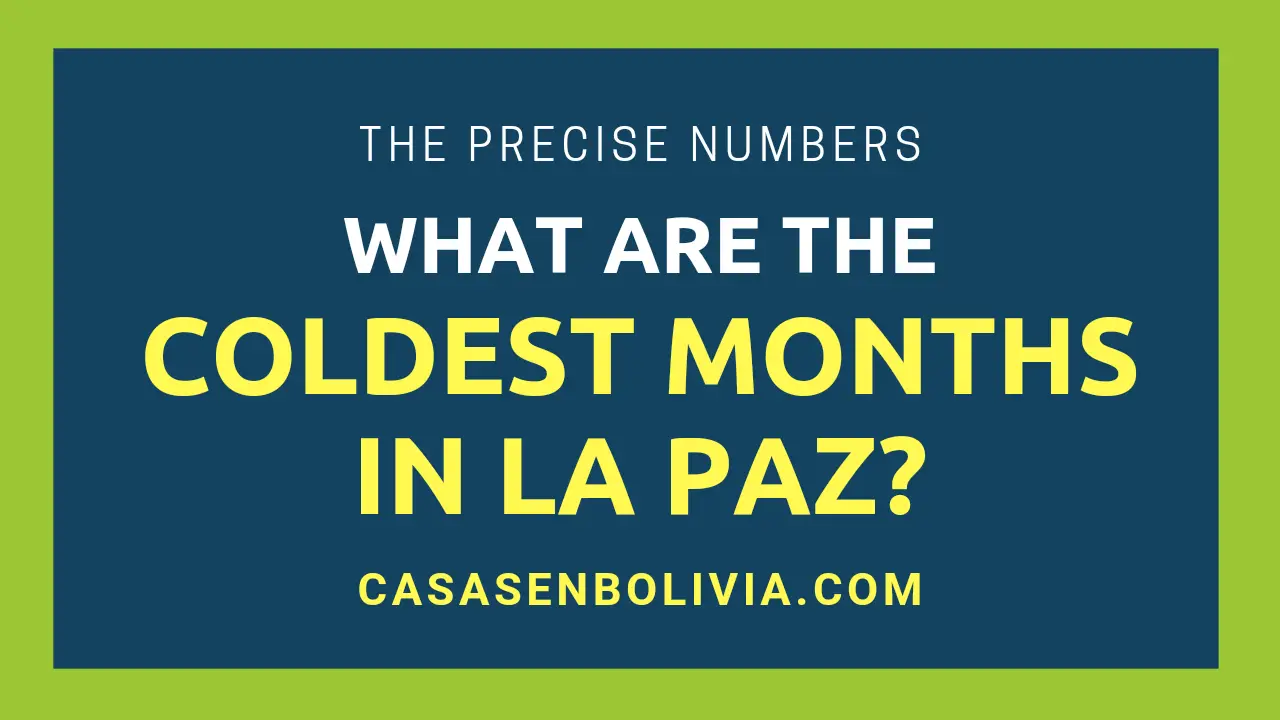Last Updated on February 15, 2025
In La Paz, Bolivia, the coldest months generally fall in the middle of the year, between fall and winter. During this period, you’ll observe many people wearing thick clothing both day and night, and in some instances, it snows. The days tend to be sunny but cold, and the air is typically dry.
The coldest months in La Paz, Bolivia, are June and July, with May and August also being very cold. June is typically the coldest month, although occasionally it’s July. Temperatures generally reach 30°F (-1°C) during the day and 50°F (10°C) at night during these two months. *Note: This is incorrect. The temperature should be the opossite. I will correct that.*
Here, we’ll discuss all the details regarding the coldest months of the year in La Paz, Bolivia. You’ll get specific temperature figures and information about hail, which can occur in the city. We are Bolivian citizens.
Which are the Coldest Months in La Paz, Bolivia?
La Paz, Bolivia, typically experiences its coldest temperatures at the end of fall and during winter. The coldest months are either June or July, *with June being the coldest month most of the time*. You should expect temperatures to decrease starting in May, reach their lowest point in late June or early July, and then begin to rise again in August.
In summary:
- Temperatures begin to drop in May.
- June is usually the coldest month, particularly in its final weeks.
- July is sometimes the coldest month, primarily in its first weeks.
- August remains cold, but less so than the preceding months.
You’ll find the coldest time of the year in La Paz, Bolivia, *between the last weeks of June and the first weeks of July*. Officially, June 21st has been designated as the coldest day in the city, but this doesn’t always align with actual conditions.
How Cold Are the Days During These Months?
In La Paz, the coldest months have the following typical temperatures:
- May, when temperatures begin to drop: 55°F (13°C) during the day and 35°F (2°C) at night.
- June, most often the coldest month of the year: 50°F (10°C) during the day and 30°F (-1°C) at night.
- July, sometimes the coldest month of the year: 50°F (10°C) during the day and 30°F (-1°C) at night.
- August, when temperatures start to rise: 60°F (16°C) during the day and 40°F (4°C) at night.
During these months, you should expect to see everyone in the city wearing thick clothing, with multiple layers. This is especially true in June and July. In this season, nighttime temperatures can sometimes reach freezing levels, and occasional snowfall occurs.
Other Climate Aspects During La Paz’s Coldest Months
Between May and August, La Paz’s coldest months, you should anticipate mostly sunny days with clear skies. The air will be dry, and the winds will be cold. In August, the winds can become turbulent on some days, reaching speeds of around 30 miles per hour. Snowfall also occurs on 3 to 10 days during these months, primarily at night.
There is minimal snowfall in La Paz, Bolivia. However, hail can sometimes be dangerous due to its intensity and sudden onset. These hailstorms typically occur during the summer, not during the winter or coldest months.
We have a comprehensive guide on how many days it snows in La Paz, including details about average snowfall and hail in the city, which, incidentally, can be dangerous in some cases. You can find it here: How many days does it snow in La Paz? All you need to know.
Conclusions:
In this article, you’ve gained detailed information about the coldest months in La Paz, Bolivia, which are June and July. June is most frequently the coldest month, with its final weeks being the coldest. May and August are also very cold.
You’ve learned that during these months and weeks, temperatures can average 50°F (10°C) during the day and 30°F (-1°C) at night. You’ve also seen that snowfall can occur during this time. You’ve also learned that there’s an officially designated coldest day in La Paz, June 21st, although this doesn’t always coincide with actual conditions. Finally, the coldest months are also typically very sunny and dry.
We hope this information has been helpful. If you’d like to learn every detail about the climate in Bolivia, including the coldest months in other principal cities, please visit our definitive guide here: How is the climate in Bolivia? A complete overview.
CasasenBolivia.com, information on living, working, investing, and traveling in Bolivia.








